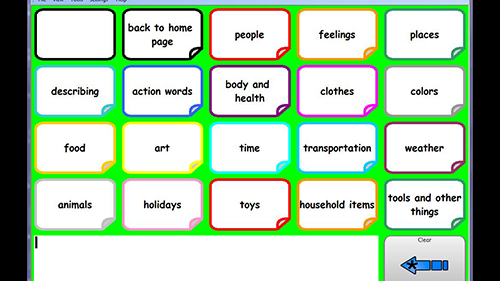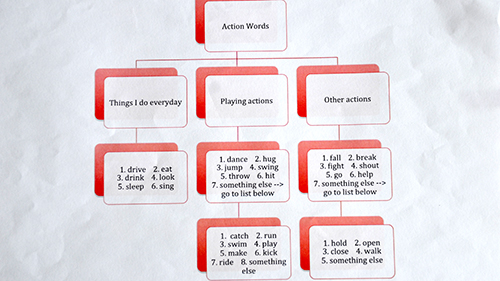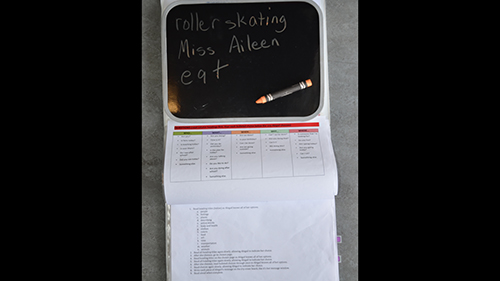Human communication is a complex, dynamic, transactional process. Effective communication is a two-way process (expressive and receptive) in which messages are co-constructed or negotiated until the information is correctly understood by both interactants. [Note: When there are more than two people communicating, the process becomes even more complicated.] When communication breakdowns occur, which they often do for students at The Bridge School, our approach is that “it is the interaction, not the individual, that is impaired”.
While language is our most powerful communication tool, enabling us to precisely share our thoughts and intentions with others, language is far from the only means by which we communicate. For example, we share meaning without saying a word using our body movements, vocalizations, and gestures.
Our students require access to multiple modes and methods of communication to express themselves and access their “rights” to communicate. Many also require supports that help them understand speech and/or the body-based signals of communication partners.
In addition to being dynamic, complex and transactional, all human communication is multi-modal and co-constructed. Effective communication, therefore, occurs when meaning is jointly established or co-constructed by interactants using a variety of strategies, which may include the simultaneous use of common, body-based modes (speech, vocalizations, gestures, manual signs, facial expressions), as well as mainstream and special electronic (speech generating devices, tablets with apps, and so on) and non-electronic technologies (visual supports, communication boards).
Multi-modal communication options have increased exponentially. Human communication in the 21st century is no longer carried out face-to-face, over the phone, or through reading and writing. Today access to communication is increasingly ubiquitous, takes place 24 x 7, and occurs over powerful new platforms using increasingly portable technologies. We communicate across vast distances in real time, at little or no cost. We also can communicate asynchronously using speech, gestures, body language, writing/reading, as well as text messages, blogs, tweets, icons, videos, photos and e-mails. These new ways of communicating provide exciting new opportunities for our students, helping them build social networks, access information and pursue their interests. They also introduce unique rules of engagement that must be learned and often taught.
Our students enter The Bridge School at a time in their lives when they are very limited in their ability to communicate. Many also have difficulty understanding spoken language or interpreting the communication signals of others because of vision, hearing or cognitive challenges. At the school, they learn to use multiple modes and methods of communication, and they also learn how to repair miscommunications using a variety of multi-modal strategies.
The Bridge School staff teach our students to use a variety of modes. They also use a multi-modal approach to teaching. Importantly, the modes/methods that support each student changes over time. As they grow older, learn, mature, develop literacy skills and express their personal preferences, they add a growing number of strategies, techniques, modes and methods to their “AAC tool bag”. Considering which modes/methods to use is often a key component of what students learn. Choices depend often upon the tasks students want to accomplish, the contexts they wish to communicate within, as well as their skills, abilities and preferences. Bridge School staff also note that the modes, methods and strategies students learn and then choose to use often depends upon the preferences, abilities and attitudes of key communication partners.
The use of body language as an effective communication strategy is dependent on multiple factors. One of the most important factors is the familiarity of the communication partner with the communicators’ use of their body, their facial expressions and their use of eye gaze. The communicator’s familiarity with the environment and with daily routines also facilitates the communication process.
In this example, the student uses eye gaze to indicate which toy she wants to take outside for recess. The teacher employs The Bridge School process of:
1. The teacher starts the communication by asking the student an open-ended question.
2. The student responds by looking at the area where outside toys are stored, turning her body in the same direction and moving her arm toward the objects.
3. The teacher observes what the student is doing, describes the student’s actions and points to the area the student has indicated.
4. The teacher confirms the intent with the student and the student responds by smiling to indicate that the teacher is correct.
5. When the student does not continue the communication, the teacher observes and interprets that the student’s facial expression indicates that it isn’t the “exact” message she wants to convey.
6. The teacher prompts the further exploration of the message by asking a clarifying question and the student uses body language and facial expressions to confirm.
This process continues until the student clearly expresses her choice of toys and the teacher responds appropriately.
Communication books are a critical component of any augmentative and alternative communication system and they are in use daily at The Bridge School. The books are unique to each student and are systematically developed to include words and concepts that the student understands and uses to communicate throughout the school day. The number of words and concepts included in a communication book grows exponentially as the student’s understanding and use of language expands. The staff and student design an index page that allows for easy navigation to a desired message and can accommodate new concepts and vocabulary as needed. The student is always included in the decision as to where the new materials will be located and given an opportunity to practice navigating to the location.
The design and layout of the pages in the book correlate to the pages programmed into the student’s electronic speech communication device. This helps ensure that when the student gets a speech generating device, they will already be familiar with where the vocabulary is located and can use an index page to navigate to the desired location with the least amount of time and effort.
In this video example below, you will see a student using partner-assisted scanning to plan an upcoming field-trip. The student is completing one of the decision-making activities in the self-determination curriculum and each student’s assignment is to develop a plan which includes where they want to go, who they want to accompany them and what they will do on the trip. The communication partner is familiar with the student and her methods of communicating.
This book, unique to the student, has been developed over a period of time and, with it, she can communicate thousands of concepts and ideas, respond to requests and questions, relate stories, indicate her knowledge of topics and direct or redirect a conversation. The content has been organized so that it can easily be transferred to the student’s electronic communication device.
The following images illustrate the organization of the communication book.

This navigation page offers broad categories of choices. The categories allow for expansion as the student’s understanding and use of language expands. The page is built with the student’s input so that it is easier to find and select the desired category.

When the student indicates the category they want to talk about is ‘People’, the communication partner turns to the People page and begins to read the top level of choices: family, caregivers and therapists, etc. Once the student has made a choice at this level, the communication partner moves to the second level: Mom, Dad, Hadley, etc. It is at this level on this page that the specific message is identified. For example, in the following video you will see the student select 1) People, 2) a teacher at school and then 3) Miss Aileen.

If the student selects the category – Action Words, the communication partner confirms the selection with the student, goes to this page and begins reading the choices on level 2. In the video, the student selected ‘Things I do every day’, and then the specific message ‘eat’.

It is helpful to have a strategy to record the student’s choices so that the communication partner can summarize the conversation. You will see in the video that the communication partner uses a dry-erase board and an iridescent crayon to write down each of the specific choices the student makes. An iridescent crayon is used to address the student’s cortical visual impairment.
In this video example, you will see a student using partner-assisted scanning to plan an upcoming field-trip. The student is completing one of the decision-making activities in the self-determination curriculum and each student’s assignment is to develop a plan which includes where they want to go, who they want to accompany them and what they will do on the trip. The communication partner is familiar with the student and her methods of communicating.
A closer look at segments of the video will clarify what educational and communication strategies are used to support this conversation.
At the outset, the communication partner suggests a plan for the communication and reviews the category pages she thinks the student will want to use. By establishing these parameters, the communication partner reduces the amount of time and effort the student will need to navigate to her choices. This strategy also reduces the cognitive load for the student by having only a limited number of items to remember when considering her choices.
Once the student and the communication partner have agreed as to a plan for the communication, they start the process with the communication partner reminding the student of the categories they will use in the conversation. As they navigate to the appropriate page, the student indicates her decision by shaking her head ‘no’ if the option is not her choice and by opening her mouth and/or using her voice to select the option.
During the course of listening to the choices, the student accidentally selects an option she does not want. Rather than respond or point out the mistake to the student, the communication partner continues to list the available options.
Repairing the breakdown is as simple as repeating the choices and giving the student to opportunity to self-correct their mistake. This method is far more effective and less disruptive than stopping in the middle of a conversation to point out an error.
As the communication proceeds, the choices are more specific and the student must attend to each option prior to making a selection. The communication partner indicates when it is time for the student to make a choice.
The communication partner reminds the student that she needs to listen to ALL the choices prior to making a decision. During the listing, the student responds to her selection, but the communication partner does not acknowledge the response, but continues until she reaches the end of the list. This is a ‘teaching moment’. It is important that the student learn to wait until all the options have been listed prior to making a choice. The strategy used by the communication partner was very effective as it did not take time nor focus away from the interaction.
Once a choice has been made, the communication partner writes down the student’s response. This note will be used when the interaction is finished and the communication partner summaries what decisions were made.
The ‘who’ question narrows down navigation choices and the student quickly makes her selection which the communication partner adds to the notes about the interaction.
At this point the communication partner asks the student a question and gives her the option of continuing with the list of people she will invite to the event. This is an important component of any interaction. The student must be given a chance to have input into the direction of the conversation at every opportunity.
The students were assigned to decide where they wanted to go, who would go with them and what they would do when they arrived. The student easily directs the navigation through the category pages and to the precise message she wants to express. At the end of her selections, the communication partner, once again, gives her an option of continuing the interaction.
The communication partner uses the notes she has taken to summarize the conversation.